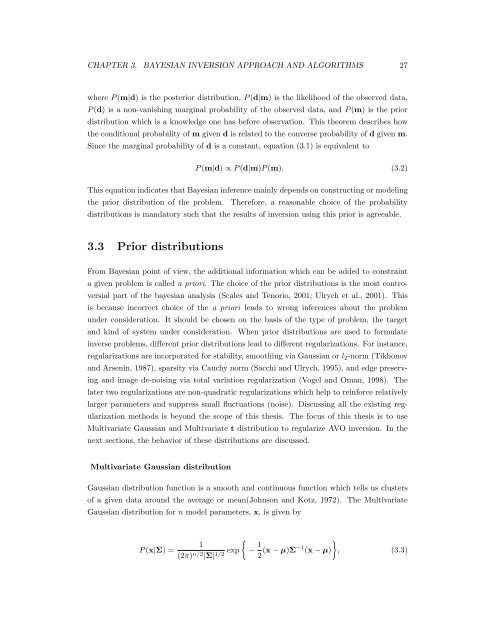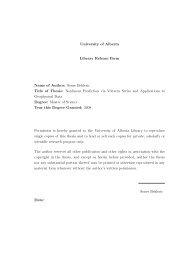Regularization of the AVO inverse problem by means of a ...
Regularization of the AVO inverse problem by means of a ...
Regularization of the AVO inverse problem by means of a ...
You also want an ePaper? Increase the reach of your titles
YUMPU automatically turns print PDFs into web optimized ePapers that Google loves.
CHAPTER 3. BAYESIAN INVERSION APPROACH AND ALGORITHMS 27<br />
where P (m|d) is <strong>the</strong> posterior distribution, P (d|m) is <strong>the</strong> likelihood <strong>of</strong> <strong>the</strong> observed data,<br />
P (d) is a non-vanishing marginal probability <strong>of</strong> <strong>the</strong> observed data, and P (m) is <strong>the</strong> prior<br />
distribution which is a knowledge one has before observation. This <strong>the</strong>orem describes how<br />
<strong>the</strong> conditional probability <strong>of</strong> m given d is related to <strong>the</strong> converse probability <strong>of</strong> d given m.<br />
Since <strong>the</strong> marginal probability <strong>of</strong> d is a constant, equation (3.1) is equivalent to<br />
P (m|d) ∝ P (d|m)P (m). (3.2)<br />
This equation indicates that Bayesian inference mainly depends on constructing or modeling<br />
<strong>the</strong> prior distribution <strong>of</strong> <strong>the</strong> <strong>problem</strong>. Therefore, a reasonable choice <strong>of</strong> <strong>the</strong> probability<br />
distributions is mandatory such that <strong>the</strong> results <strong>of</strong> inversion using this prior is agreeable.<br />
3.3 Prior distributions<br />
From Bayesian point <strong>of</strong> view, <strong>the</strong> additional information which can be added to constraint<br />
a given <strong>problem</strong> is called a priori. The choice <strong>of</strong> <strong>the</strong> prior distributions is <strong>the</strong> most contro-<br />
versial part <strong>of</strong> <strong>the</strong> bayesian analysis (Scales and Tenorio, 2001; Ulrych et al., 2001). This<br />
is because incorrect choice <strong>of</strong> <strong>the</strong> a priori leads to wrong inferences about <strong>the</strong> <strong>problem</strong><br />
under consideration. It should be chosen on <strong>the</strong> basis <strong>of</strong> <strong>the</strong> type <strong>of</strong> <strong>problem</strong>, <strong>the</strong> target<br />
and kind <strong>of</strong> system under consideration. When prior distributions are used to formulate<br />
<strong>inverse</strong> <strong>problem</strong>s, different prior distributions lead to different regularizations. For instance,<br />
regularizations are incorporated for stability, smoothing via Gaussian or l2-norm (Tikhonov<br />
and Arsenin, 1987), sparsity via Cauchy norm (Sacchi and Ulrych, 1995), and edge preserv-<br />
ing and image de-noising via total variation regularization (Vogel and Oman, 1998). The<br />
later two regularizations are non-quadratic regularizations which help to reinforce relatively<br />
larger parameters and suppress small fluctuations (noise). Discussing all <strong>the</strong> existing reg-<br />
ularization methods is beyond <strong>the</strong> scope <strong>of</strong> this <strong>the</strong>sis. The focus <strong>of</strong> this <strong>the</strong>sis is to use<br />
Multivariate Gaussian and Multivariate t distribution to regularize <strong>AVO</strong> inversion. In <strong>the</strong><br />
next sections, <strong>the</strong> behavior <strong>of</strong> <strong>the</strong>se distributions are discussed.<br />
Multivariate Gaussian distribution<br />
Gaussian distribution function is a smooth and continuous function which tells us clusters<br />
<strong>of</strong> a given data around <strong>the</strong> average or mean(Johnson and Kotz, 1972). The Multivariate<br />
Gaussian distribution for n model parameters, x, is given <strong>by</strong><br />
P (x|Σ) =<br />
1<br />
(2π) n/2 <br />
exp −<br />
|Σ| 1/2 1<br />
2 (x − µ)Σ−1 <br />
(x − µ) , (3.3)









